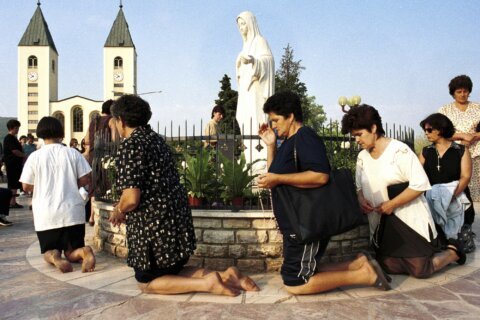Kids aren’t cheap. That’s the consensus among both the government and parents, but exactly how much kids cost is up for debate.
For years, the U.S. Department of Agriculture published an annual report that calculated the average cost of raising a child to adulthood, not including college expenses. That report was long considered the gold standard in calculating the cost of children, but it hasn’t been updated since 2017.
At that time, it found the cost of raising a child born in 2015 was $233,610. That assumes the child was born to a middle-income, married couple. When adjusted for inflation, the number jumps to $312,202 as of March 2024, based on data from the U.S. Bureau of Labor Statistics.
However, the true price could be even more.
Isabel V. Sawhill, a senior fellow emeritus in economic studies at the Brookings Institution, says the USDA figure assumes a 2.2% inflation rate, much lower than what the country is currently experiencing.
“(In 2022), I compared this period we’re going through now to the last time we had a bad case of inflation,” she says.
Using data from the late 1970s, she adjusted the expected inflation rate to 4% on average, which results in a total cost of $310,605 to raise a child in a middle-class home from birth to age 18. At that same time, the USDA estimate, when adjusted for inflation, was only $290,014. Like the USDA, Sawhill’s figure doesn’t include college expenses.
These numbers aren’t necessarily reflective of all families’ experiences, though. There are many circumstances and choices that can increase or decrease the cost of child rearing.
But still, for some families in the trenches, these numbers don’t sound too far off. “I think it’s completely accurate,” says Shannon LaRosse, a mother of two and investment advisor representative at Informed Family Financial Services in Norristown, Pennsylvania.
How Much Does It Cost to Raise a Child?
Using the Consumer Expenditures Survey, the USDA found that the cost of raising kids can vary by region, with the northeast being the priciest location in the nation.
For children born in 2015, average spending breaks down into the following percentages, according to the USDA:
— Housing: 29%
— Food: 18%
— Child care and education: 16%
— Transportation: 15%
— Health care: 9%
— Miscellaneous: 7%
— Clothing: 6%
Those percentages may have changed in recent years, through.
A 2024 Cost of Care Survey from Care.com found that parents spent, on average, 24% of their household income on child care in 2023. Average day care costs ranged from $219 per week for one child at a family care center to $755 per week for one child to receive care from a nanny. Nearly half of those surveyed spend more than $1,500 per month — or $18,000 per year — on child care.
Of course, that all depends on if a parent can even find day care openings. Care.com found 65% of survey respondents spent time on a day care waitlist while 43% reported waiting four months or longer for a spot to open.
In response to challenges regarding the availability and cost of child care, some parents are looking for free day care options. More than a third turn to family and friends for help, and 30% say it would be helpful if their employer provided on-site day care.
Many parents have even had to adjust their employment or career trajectory to reduce the cost or need for child care. “You may choose a job that doesn’t have as much salary but has flexibility and benefits,” LaRosse says.
Given how much day care is, Care.com says more than 90% of parents would like to hear the 2024 presidential candidates address the issue during debates.
[READ: Is Summer Camp Tax Deductible?]
Factors That Influence Child Raising Costs
While average costs can be helpful for budgeting purposes, they can also paint an overly bleak picture of parenting. Many parents can and do spend significantly less.
“It can be less or more depending on household income and how (parents) choose to spend their money,” LaRosse says. She notes that a household’s list of wants may be longer once children are added to the mix, and parents who want to rein in costs may need to consider whether some expenses are truly needed.
Grandparents nearby who are willing to babysit for free can all but wipe out child care expenses. Meanwhile, monthly mortgage and rent payments may be lower for those living in cities with affordable housing, such as Huntsville, Alabama, or Green Bay, Wisconsin.
However, there are trade-offs to living in some states with a lower cost of living. For instance, parents in northern states need to buy clothing appropriate for four seasons. The cost of winter boots, coats and other apparel can add up.
As kids age, they may have more expenses for school activities, sports teams and electronic devices. One way to minimize these costs is to ask teens to find a job and pay for their own discretionary expenses.
“Regardless of economic status, I have clients that range from those that cover all of their children’s expenses … to very well-to-do clients that want to make sure their children appreciate the value of a dollar,” says Tammy Trenta, founder and CEO of asset management firm Family Financial in Los Angeles.
“They work during their high school years, are responsible for buying their own car and paying their own car insurance and cell phone bill,” she adds.
For parents inclined to take the former approach, Trenta encourages them to consider whether they are doing their child a disservice by not preparing them for the realities of managing their own money later in life.
[READ: Kids and Taxes: 6 Tax Credits Parents Should Know About]
Are You Able to Afford a Child?
While the choice to have children shouldn’t be reduced to merely a financial decision, money can’t be disregarded completely.
“Finances should always be a factor when considering expanding your family,” Trenta says. “Sure, there are ways to lower this amount, but each additional child you have could result in five more years that you need to continue working.”
There are immediate costs associated with the birth or adoption of a child that couples can anticipate. However, after that, parents usually have significant flexibility in how much or how little they spend on their kids.
Having multiple children can raise costs — but perhaps not as much as people expect. Parents may already have a home and vehicle large enough to accommodate multiple children. Child care providers may also offer sibling discounts. Plus, clothes and toys can be passed down to younger siblings, and food that is purchased in bulk can result in a lower per-serving cost.
Rather than relying on statistical averages, LaRosse recommends prospective parents talk to people who currently have young children. Experienced parents can be the best source of information on how much families actually spend on kids in your area.
[Relaated:How to Save Money for Your Kids]
Budgeting for a Baby
For would-be parents, the various numbers come with bad news and good news. The bad news is that the savings they have prepared in anticipation of a baby might not be enough. The good news is there is a wide variation in the cost estimates because so many expenses are optional.
Rather than buying expensive gadgets, upsizing the house for more space and insisting on buying new clothes, parents can keep costs down by making due with what they have already. Parents may also want to consider buying secondhand, maximizing the use of grocery savings apps and rethinking expensive family vacations. Limiting extracurricular activities can also rein in costs.
[Related:Grocery Receipt Scanning Apps You Should Try]
Other ways to make raising children more affordable are outside the control of parents. “It’s worth pointing out that other advanced countries do a lot more to help parents raise children,” Sawhill says.
Almost every nation in the world has a national paid parental leave policy, the Bipartisan Policy Center says. The U.S. is one of only six countries without one. Some countries, like Belgium and Norway, offer free child care, while other rich countries subsidize it heavily, according to UNICEF.
Barring any change of heart from legislators, parents shouldn’t expect those things anytime soon. Instead, couples should honestly evaluate not only their finances but also their commitment to sacrificing creature comforts for the sake of raising children.
For those who make the leap to parenthood, they may find there is ultimately only one word to describe the cost of kids: priceless.
More from U.S. News
Ways to Save for Your Child’s College Education
How Multiple Kids in College Affects Financial Aid
How to Talk About Money With Family — and Why It’s Important
How Much Does It Cost to Raise a Child? originally appeared on usnews.com
Update 05/09/24: This story was previously published at an earlier date and has been updated with new information?







